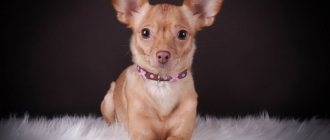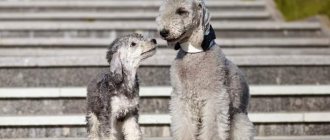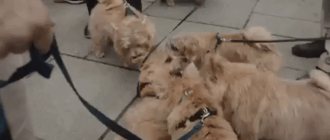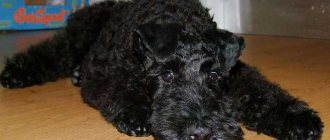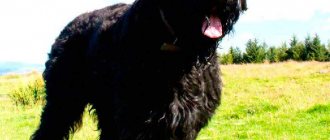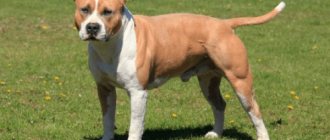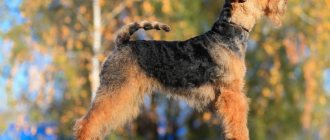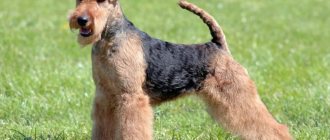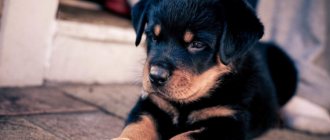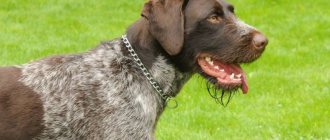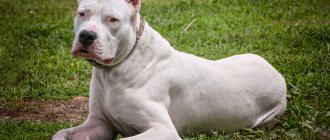The Border Terrier is not the most famous breed. There is not much information about her. But we suggest that all breeders who are looking for an active and cheerful pet be armed with basic information about this species.
This small, mischievous dog was previously used for hunting. Now she serves as a companion. The Border Terrier will brighten up your loneliness and bring a lot of positive emotions into your life. This is an ideal dog for families with middle-aged and older children who lead an active lifestyle.
Description of the Border Terrier breed
Popularity 238th place among 263 dog breeds
Lifespan:
12-15 years
Height:
35-40 cm
Country of origin:
Great Britain
Average price:
30-40 thousand rubles
Weight:
5-7 kg
Latest articles Cat health
Ataxia in cats: what is it, how does it manifest and is treated 01/23/2022 180 0 0
Cat health
Leukemia, or viral leukemia in cats 01/23/2022 156 0 0
Health
A purebred Border Terrier puppy is in good health. A balanced diet, proper care and preventive measures minimize the risk of infections and the development of dangerous diseases.
Most Border Terrier health problems are related to injuries that the dog can receive while hunting. The dog should be constantly examined for wounds and abrasions to prevent bacterial infection.
Contact with wild animals requires regular vaccination and constant treatment of the border against parasites. The main danger for the working terrier is rabies.
Diseases
The origin and description of the breed indicate minimal human participation in the formation of Border Terriers. This fact has a positive effect on their genetics, reducing the risk of hereditary diseases. Little hunters are predisposed to the following diseases:
- obesity due to overeating or low physical activity;
- cardiovascular pathologies;
- intestinal adhesions;
- retinal atrophy;
- cataract;
- joint dysplasia.
Another feature of border patients is a slow reaction to general anesthesia.
Vaccinations
Border Terrier dogs are vaccinated annually against:
- rabies;
- carnivore plague;
- parvovirus;
- parainfluenza;
- leptospirosis;
- infectious hepatitis.
The first vaccination of puppies is usually carried out by breeders before sale, when the baby reaches the age of 6-8 months, and revaccinated after 2 weeks. The next stage of vaccinations will be done at 6-7 months. Further vaccinations are carried out every 12 months according to the schedule prescribed by the veterinarian.
Key facts
The Border Terrier will be an excellent pet for a family with a child over 7 years old. This active kid will always find a reason to have fun, and together with the children he will never be bored. However, this is only possible if the child is familiar with the rules for handling animals. The dog will not forgive the insult and will try to take revenge at the first successful opportunity.
The dog will not cause problems for adults. The characteristics of the Border Terrier breed say that it is obedient and very responsive. These dogs are not used to shaking their license and trying to take the place of leader. They are much more interested in acting with you than against you. Like all English dogs, terriers are incredibly intelligent and mannered - exactly what an English gentleman should be.
Border Terriers gain weight very easily, so it is important to carefully monitor their diet, adjusting it depending on the dog's weight. The description of the Border Terrier breed emphasizes proper feeding.
The Border Terrier was created to live in a family - that is, among people. If you put him on a chain and drive him out to live in a booth, he quickly degrades, becomes noisy and aggressive. An aviary is also not suitable: the dog will quickly get out of it, because throughout history its main occupation has been burrow hunting. And after escaping, the pet can easily get hit by a car, since he is not at all afraid of noise.
It's hard to know when a Border Terrier gets sick. He doesn't show pain like all other dogs, he doesn't whine. If the dog has become lethargic and apathetic, this is a reason to consult a doctor.
In general, the health and life expectancy of the Border Terrier pleases the owners - the cute dog is quite capable of living without serious illnesses for up to 15 years.
Application
The short stature and long muscular legs of the Border Terrier determined the breed's use in hunting small animals. At “work” these animals become tough and purposeful. They are used in hunting:
- for game;
- on ungulates;
- parfosnoy;
- burrow
These dogs show good results both alone and when working in a pack. In their homeland, Border Terriers excelled at herding, obeying commands well, helping to gather flocks of sheep and guarding them. But without the presence of the owner, the security qualities of the border dog are noticeably reduced. They do not feel wary or suspicious, but bark as a greeting rather than as a warning of danger.
The lack of a bright, pleasant appearance does not prevent the breed from mastering a new direction of use - canis therapy. In the UK, dogs of this breed are kept in nursing homes, orphanages and specialized hospitals to work with the elderly, children and the disabled.
If you pay a lot of attention to raising your pet, the Border Terrier will make a reliable companion dog.
History of the origin of the Border Terrier
The first mention of the Border Terrier dates back to the 19th century. In documents from those times, a mention was found of “dogs from the British Isles,” as well as a picture depicting the process of hunting with a whole pack of this breed.
Dogs appeared in the Northumberland region, on the border of Scotland and England. This is where the name of the breed comes from, because “border” translated from English means “border, edge.” The official name “Border Terrier” was adopted in 1880.
The British used these dogs to hunt small animals such as otters, foxes, badgers or rabbits. And terriers did their job well: they could wander or run through the forest for hours, along with horses and other hunting dogs.
However, the breeders set themselves the task: by crossing these dogs with other breeds, to make terriers resistant to any weather conditions, be it cold or wind. And over time they succeeded.
For a long time, breeders did not want to register Border Terriers with the English Kennel Union, as they were afraid that the development of breed standards would only worsen the hunting qualities of the breed. However, in 1920 this still happened. It was then that the first Border Terrier Club in Britain was created.
Today, Border Terriers are quite common in the UK as hunting dogs, but in the rest of the world they are not so popular, and they are kept only as pets.
Mating
The first mating is carried out no earlier than 1.5 years (for males 1 year), although it is advisable to wait until 2-2.5, which is when the dog reaches full maturity. To select a match for your pet, the owner needs to contact the kennel club or directly to the owner of a suitable candidate.
Parents are selected taking into account that the advantages of one compensate for the disadvantages of the other, and all the positive characteristics are only enhanced in the future offspring.
Both members of the pair must have sufficient show scores for breeding that confirm their suitability for the future goal. Parents must have age-appropriate vaccinations and be treated for helminths. At the first meeting, the female is brought to the male’s territory, mating is repeated 1-2 more times with an interval of about a day.
Read a detailed article on the topic: “Everything you need to know about breeding dogs: appropriate age, what to do if it doesn’t work out, rules and tips.”
Appearance of the Border Terrier
In the photo, the Border Terrier seems like a small and rustic dog. In fact, her advantages are not her appearance, but her character and physical characteristics.
General impressions
The Border Terrier is a small dog with a coarse, wavy coat. She has a narrow body, thanks to which she can crawl into any holes, and long legs to run quickly. Over the course of history, the appearance of the dog has not changed too much.
Head
The Border Terrier's head is medium-sized, with a wide, smooth stop and a short muzzle. The teeth are quite large, white, and set into an even scissor bite. The eyes are round, the whites are closed with eyelids. The color of the iris varies from brown to black.
The nose is large, black, with wide open nostrils. The expression of the muzzle is calm and intelligent. The ears are small, pressed tightly to the head, and have a V-shape.
Neck
The neck is short, moderately muscular. No suspension.
Torso
The body is strong, muscular, densely covered with hair, which allows the terrier to remain dry in any weather. The back is wide, the croup is well-shaped. The chest drops almost to the elbows.
The dog's tail is small, tapering from base to tip. Set high.
Forelegs
The front legs are elongated, the elbows are parallel to the body.
Hind limbs
Straight, with strong joints. The fingers are gathered into a dense ball, all approximately the same length and ending in hard claws that match the coat.
Movement
The Border Terrier moves freely, without waddling or limping, at a fast trot.
Wool
The coat of Border Terriers is thick and dense, with a good undercoat. The dog's lining fits tightly to the body, protecting it from precipitation and external damage.
Color
Several colors of border terriers are acceptable:
- gray and tan;
- blue and tan;
- wheat;
- reddish-sandy.
Black shades should not occur.
Size
The size of the Border Terrier is small: the height at the withers is not strictly fixed by standards. On average, the height of a Border Terrier can range from 27 to 37 cm.
You will have to monitor your pet's body weight - dogs are prone to obesity. A healthy weight for a Border Terrier is 5-6.5 kg for females and 6-7 kg for males.
Character and behavior
By nature, the Border Terrier is extremely attentive, friendly and affectionate; he loves long walks and gets along well with everyone, including children. Very sociable, needs the company of people, but for complete happiness it must also communicate with relatives of different breeds.
Border is lively and energetic, but not noisy. He does not require special attention. Always vigilant and reasonable. It will definitely warn the owner about the arrival of guests or extraneous noise with a ringing bark. However, he is categorically unsuitable for the role of a guard and protector; he is too friendly even to strangers. Gets along well with other animals, except for small rodents and birds, which are considered by him as an object of hunting. He will selflessly chase the neighbors' cats and squirrels, but usually does not touch his own. Rarely is pugnacious towards other dogs. Borders are not known for their modesty; they always want to be the center of attention, are happy to show off their talents and enjoy admiring glances.
Borders are not homebodies and will not lie on the couch for days, so they are suitable for active people who love long walks, are ready to walk a lot with the dog, provide it with games or interesting activities (agility, hunting, other sports).
The most important thing for a Border Terrier is attention from the owner, in whose company the dog thrives. He is brave and fearless, which is especially noticeable in the work of a gambling hunter. With the appearance of a decorative dog and small size, the Border Terrier remains a strong working dog with a stable psyche; it will never become hysterical, collected and restrained. The owner always needs to remember about the pronounced hunting instinct. While walking, even an obedient and well-trained dog can suddenly break loose and rush after a bird, cat or rodent.
Border Terrier Personality
All owners are sure of one thing - the character of Border Terriers is soft and flexible. The dog is friendly, always ready to frolic and play with the owner. This baby becomes attached to its owner for life. There are cases where a terrier died during a long separation.
Attention and communication with people is a necessity for the Border Terrier. They need active play every day and, if possible, meetings with other dogs of different breeds. This will make the dog's life truly happy.
Borders were distinguished by their good, stable psyche, courage and endurance unimaginable for a dog of this size. The dog will be friendly with a new person, but will still sniff him without losing his vigilance.
Although the terrier is not very large, he is always ready to protect his family - and especially his owner. He will attack even a larger dog completely fearlessly.
Despite such bravery, in the domestic circle the terrier is absolutely calm and affectionate. He will happily lie next to you while you watch TV, and then play ball or go for a walk. A dog loves all family members, but it has much higher feelings for its owner.
If it's raining outside, that's no reason not to go for a walk! This is the Border Terrier's motto. Its dense, hard coat with a thick undercoat prevents raindrops from reaching its delicate skin. So you will have to walk every day, regardless of the weather. And such an active and cheerful dog needs from 2 to 4 hours of being outside every day.
Do not deny yourself and your pet the desire to play something in the nearest park. Bring a ball or frisbee from home and let your dog get some exercise without a leash.
Border Terriers are often found in nursing homes. They are great at brightening up the time for elderly people, and they are also used as four-legged doctors. In Europe this is especially popular.
Key points in training
Terriers are very smart, love to work and fulfill the wishes of the owner, so they are easy to train. Considering that border babies mature slowly, it is better to use a game strategy when teaching. Training should begin from the moment the pet appears in the house, paying special attention to the commands “Come to me” and “No”.
Like all terriers, Borders are stubborn and try to dominate. Therefore, training must be persistent; the pet should not be allowed to decide whether he will follow the command or not.
Read about how to properly train a dog in the article: “Training a puppy: effective methods from dog handlers, learning commands at home.”
You should not shout or hit the dog if it refuses to complete tasks and is offended by the owner. It is better to use the most interesting and varied tasks that will make the animal think, reinforcing the execution with praise, stroking, and treats.
Terriers can also be used for hunting; the working qualities of the representatives of the breed are not lost. Preparation begins from an early age, and before taking part in the process for the first time, it is necessary to make sure that the animal responds to the owner’s call and is able to withstand the load. It is advisable to provide your pet with an address card and a chip in case of loss.
Education and training
Border Terriers are incredibly smart and intelligent animals. Their training will not give the owner almost any difficulty. There are several things that are important to teach your puppy at a young age.
Train your dog to walk in noisy places. Terriers get along well even in small apartments. This means that they will have to walk through busy and sometimes very noisy places.
Once the puppy has become comfortable in his own yard, begin to gradually take him out into noisier areas: walk along highways or in parks where there are a lot of people. Don't scold your puppy if he barks or runs away from the doorbell or noisy TV, but don't reassure him either. The dog will take this as encouragement and will only try harder. Try not to pay attention, and next time sit down to watch TV with him.
If this practice is not carried out in childhood, the dog will grow up timid and fearful. It will be difficult to cope with the upbringing and training of a Border Terrier at a more mature age.
Well, you can carry out the training process either independently or with the help of professionals. Do not forget that if the owner trains his dog himself, their bond becomes even stronger, as does mutual understanding. No training session with a curator can replace the time you could spend together.
Do not scold the terrier if he cannot carry out some commands right away. This will make the dog unsure of itself and develop a dislike for training. Do not forget that regardless of its success, the main goal of the animal is to be useful to the owner. The dog himself understands that he made a mistake; there is no need to tell him about it again.
Try to diversify your activities and make them more interesting. For example, instead of throwing a stick onto a well-mown lawn, throw it into the bushes and let your dog enjoy finding it.
It’s better to build a walk plan based on some rules:
- at least half of the time spent walking should be taken up with exercises, team training and other useful activities;
- let the dog run around without a leash for a while: let the baby dig a hole, sniff the bushes or bark at a stray cat;
- play with the dog: take a ball or other pet toy for a walk - let him run after it, look for it - or have a chase.
Don't forget to reward your dog while playing. Pet her for the ball she brought you and give her a treat. Border Terriers perform well in active sports, be it speed running or agility.
Pros and cons of the breed
The Border Terrier, despite its friendly disposition, is not suitable for all people. This dog is full of energetic energy, so its owner must also lead an active lifestyle.
The main advantages of the Border Terrier:
1. Friendliness, loyalty. 2. Intelligence and intelligence. 3. Loves children. 4. Suitable for apartment maintenance. 5. Gets along well with other dogs. 6. Not expensive to maintain.
Border Terrier Health and Diseases
Border Terriers are considered one of the healthiest dogs. The dog's immunity is as strong as its physique. However, this does not mean that they managed to avoid absolutely all diseases.
Possible diseases
The most serious problems that can arise are joint dysplasia or necrosis of the femur.
In rare cases, veterinarians may discover that a dog has epilepsy or some kind of heart disease. But experts say that good physical activity will help avoid these diseases.
During puppyhood, dogs may develop coordination and brain disorders. Unfortunately, this disease is already irreversible. However, such individuals differ from their healthy counterparts in appearance, and therefore the risk of buying a sick puppy is minimal.
Reproductive health
Estrus in Border Terriers begins at the age of 10 months and usually lasts up to 23 days. During this period, the dog may behave apathetically, but by the 8th day the animal’s condition should improve. If the dog eats poorly, refuses to go for a walk, or constantly sleeps, this is a reason to contact the veterinarian, because internal bleeding may be mistaken for estrus.
It is recommended to breed Border Terriers from 3 to 8 years old. This is the optimal age for both males and females. Mating too early or too late can affect not only the litter, but also the health of the dog.
Also, a bitch should not be allowed to become pregnant more than once a year. Her litters will be of lower quality and fewer in number. A dog usually gives birth to 5 to 10 puppies. In rare cases, their number can increase to 12.
Possible diseases
The breed is a long-lived dog, they live up to 20 years. In addition, they are known for high immunity and low disease rates. Some diseases, however, can appear in a pet.
The most common:
- dysplasia of the hip joints of the hind legs (mostly hereditary);
- eye cataract;
- epilepsy;
- obesity due to poor nutrition;
- allergic reaction to any food;
- Puppy ataxia (death of newborn puppies within a few days after their birth, caused by infectious diseases).
The level of genetic diseases, compared to other breeds, is very low.
Features of feeding and diet
The Border Terrier does not need specialized food, nor does it need fancy food. However, from a young age, the puppy is taught to eat healthy food. As an adult, the dog can be fed both dry food and raw meat.
Up to 1.5 years, a dog’s diet should consist of:
- boiled meat (beef or lamb);
- low-fat fermented milk products, cottage cheese;
- once a week you should give a boiled egg;
- buckwheat and millet.
These products contribute not only to the full saturation of the baby, but also to strengthen his bones, muscles and ligaments, which allows him to grow strong, healthy and cheerful.
You need to carefully monitor your Border Terrier's diet. These dogs love to overeat, as a result of which they quickly gain weight. It is important to regulate the portion size regardless of whether the dog is fed dry food or homemade food.
Feed your dog 3-4 times a day in small portions. This will prevent the small stomach from stretching and the dog will not feel hungry. When it's time to switch your dog to dry food, grind it up and soak it in water or milk for the first few weeks. Introduce any supplements into your diet only as directed by your veterinarian.
Breed traits
Breed traits (on a 5-point scale)
| Border Terrier | |||
| Activity | in the house | 4 | |
| on the street | 4 | ||
| Obedience | training | 3 | |
| strangers | 3.3 | ||
| Domination | in family | 2 | |
| over dogs | 2.2 | ||
| Defending your territory | from people | 2 | |
| from dogs | 2.8 | ||
| Sociability | in family | 5 | |
| with strangers | 4 | ||
| with dogs | 3 | ||
| Concentration | in family | 1 | |
| in front of strangers | 1.6 | ||
| with dogs | 2 | ||
| Aggressiveness | in family | 1 | |
| to strangers | 2 | ||
| to the dogs | 2 | ||
| to cats | 2 | ||
| Family behavior | calmness | 4 | |
| demand for affection | 4.7 | ||
| excitability | 4 | ||
| playfulness | 4.3 | ||
| excessive barking | 2 | ||
| behavioral breakdowns | 2 | ||
| Tolerance for children | up to 4 years | 3.5 | |
| over 4 years old | 4 | ||
| Institutional use | watchman | 3.4 | |
| bodyguard | 1.6 | ||
This breed is often compared to the following dog breeds: Bedlington Terrier, Australian Terrier, Affenpinscher, Beagle, Miniature Schnauzer (Dwarf Schnauzer).
The photo shows what a border terrier looks like:
Care and maintenance
Due to their compact size, Border Terriers get along well even in small apartments. However, they also feel good in a country house. Because of its energy, the dog needs systematic walks, active games and physical activity.
Until the puppy reaches 7 months of age, he cannot control his bladder. At this age, you can teach him to go to the litter box. After every meal or nap, put your baby in the toilet so that he can do all his business. Don't forget to praise him for such a feat. You can take your dog outside only from 6 months after he has received all the required vaccinations.
The dog's bed should be in a quiet, moderately lit place. You should not put the dog mattress in the darkest corner, but bright light will make sleeping uncomfortable. A corner in the hallway or bedroom is perfect. The main thing is that there are no drafts or any heating devices in the place where the dog sleeps in order to avoid colds and overheating, respectively.
You need to brush your dog several times a week with a special brush. Although the Border Terrier does not shed much, if dead hair is not removed, it will spread throughout the house.
It is enough to bathe your dog once a month using regular dog shampoo. Avoid taking long baths – it’s better to just water your pet with water from the shower. Avoid getting water in your ears. After each walk, wash your dog's paws or dry them with a damp cloth.
Even if you keep your dog in a private home with its own yard, it still needs regular walks. On average, a walk should last 45-70 minutes and be done at least 3 times a day. A relaxed walking walk will not do; the Border Terrier needs an asset. Take your dog where there are no people and you can let him off the leash. Play with her, let her run around to her heart's content.
The coarse coat of the Border Terrier is usually trimmed - dead hairs are manually plucked out, allowing new ones to grow. This should be done at least once every 2 weeks, but not earlier than the dog is 6 months old. Experienced dog breeders do not recommend cutting border terriers, because after this the structure of the coat is disrupted and it loses its natural density. It may take up to 1 year to recover.
Remember to check your dog's eyes and ears daily for dirt. Do this after every walk or hunt. Dogs love to run through bushes and tall grass, where they can pick up ticks or other living creatures. If necessary, clean the eyes with cotton pads soaked in warm boiled water or chamomile decoction, and a cotton swab is perfect for the ears.
You need to brush your dog's teeth 3-4 times a week using a special brush and toothpaste, and also give the dog cartilage as a preventive measure. It is enough to trim the nails once a month.
With proper care and maintenance, a Border Terrier will live with you for 13-15 years, and perhaps a little more.
How to choose a puppy
Before you buy a baby of this breed, you need to contact a nursery with a good reputation or a private breeder . An animal purchased secondhand does not have proof of origin and may grow up to be completely different from the desired exterior.
During your first visit to the breeder, it is advisable to check the pedigree and show scores of the parents. In this case, you can get guarantees that the puppy will grow up to be a Border Terrier and not something else.
Both the mother and father of the baby must be healthy, with completed veterinary passports, vaccination and deworming records. It is advisable to request from the breeder the results of testing for dysplasia, ataxia, and spongiform leukoencephalomyelopathy.
The puppy should not show signs of illness, aggression or cowardice. The breeder issues a veterinary passport for it with the first marks and a metric, which the owner will later exchange for a pedigree.
Borders are good family pets, provided they have an active lifestyle and treat the dog correctly. Caring for him is not difficult, the dog is in good health, and is also focused on human contact - all this allows you to keep the dog in an apartment environment and helps you become an ideal pet.
5 / 5 ( 3 voices)
Tips for choosing a puppy
Attention should be paid not only to the appearance of the puppy, but also to its behavior. A healthy baby will run and play. Having noticed a visitor, he will run up and start sniffing you. If the baby does not play with his brothers and sisters, but sits alone, know that training or treating such a dog will cost you your own nerves.
Find out as much as you can about not only the Border Terrier puppy's parents, but also about their previous litters. Contact people who bought puppies before you and ask about their health and behavior. They usually don't vary much from litter to litter. If you feel that you cannot figure it out on your own, invite a knowledgeable person with you who will ask all the necessary questions.
You can separate a puppy from its mother no earlier than two months, or even later. At this age, babies are already quite independent and quite active. Vaccinations for this age have already been done, and the quarantine has passed after them. In addition, the character of the future pet is already making itself felt, which will give you the opportunity to independently choose the dog with which you will spend the next few years of your life.
Please pay attention to the conditions in which dogs are kept. If they are kept in a cage, it must be clean. If in an enclosure, there must be hay or bedding where dogs can sleep or just lie around. They should always have access to their mother and a bowl of clean water. Puppies should be clean and smell good. There should be no dirt or debris of solid food in the mouth or under the tail.
You should not take a puppy from a breeder if:
- you are not allowed into the dogs' enclosure;
- they are not allowed to meet the parents of the litter;
- the owner cannot provide you with evidence of the parents’ merits;
- the enclosure is dirty and smells of dog waste products;
- The owner breeds dogs of a different breed.
All this can lead to the purchase of an unhealthy or non-purebred baby. It’s better not to risk it and visit another nursery.
Price and where to buy
When buying a puppy, you need to choose a kennel. There are several of these: Miksmira, Greenferry and others. Price ranges from 10,000 to 50,000 rubles. When purchasing, you need to get to know the breeders, look at the living conditions of the dogs, the puppy’s parents (if possible), and check all the documents.
Pros and cons of the breed:
| Advantages | Flaws |
| Keeping possible in an apartment or country house in an insulated enclosure | The hunting instinct is highly developed, so it can run after a cat and get lost |
| Finds a common language with children | Digs holes near the fence, can jump over a small fence |
Thus, the Border Terrier is a rare hunting breed of dog. It has changed little over the period of development. This energetic baby will become a favorite of children and a good companion for hunters.
Pedigree standards
- Small flat head.
- The muzzle is decorated with a neat beard.
- Dense row of teeth with a scissor bite.
- Black nose with dark brown nose.
- Almond-shaped eyes of dark brown shades.
- Small, triangular-shaped ears droop.
- Strong physique.
- Proportional neck, slightly elongated.
- The chest is not very deep.
- Extended legs.
- High tail. Strong and thick, tapered at the end.
Choosing a nickname
The Border Terrier comes from England. It is better to choose resonant, loud nicknames that have something connected with Great Britain. The main task is that the name should be well remembered and perceived by ear.
| For males: | Art, Biffy, Blade, Break, William (Willie), Heinrich, Jarrett, Jerry, Kelvin, Cody, Corey, Nolan, Pikachu, Ralph, Rauf, Remmy, Ricci, Roger, Sally, Studdy, Tobby, Thorne, Fox, Chain , Sheldon, Yunni. |
| For Border Terrier girls: | Irish, Alfreda, Arena, Bonnie, Britta, Bria, Jane, Diana, Keira, Corrie, Lucy, Myla, Megan, Melody, Note, Paris, Sydney, Fiji, Chelsea, Sherrill, Ellie. |
The dog will remember, learn and respond to an easy name faster.
Nutrition
The Border Terrier breed is not picky about food, but there are several recommendations that must be followed:
— dogs need a properly balanced diet;
- half of the diet should consist of protein foods, since they are very mobile and spend a lot of energy and strength;
- tubular bones, fatty meats and cereals, dishes with spices, sweets, smoked and pickled foods are prohibited;
- you cannot give them foods that cause fermentation processes in the body;
— it is recommended to feed 5-6 times a day, but not in large portions;
— before introducing a new product, it is imperative to check the animal for allergies. To do this, you need to give a little product and observe the dog for several days;
- do not tolerate bread and potatoes well; the latter is best eaten as a puree;
- it is necessary to often give cottage cheese, fermented milk products, quail eggs, vegetables;
- lean pork, beef should be present in the diet every other day. Meat is necessary to maintain muscle tone and normal function;
— a good solution would be to feed your pet with special top-class food;
- It is necessary to give special vitamins that maintain bones and teeth in normal condition.
